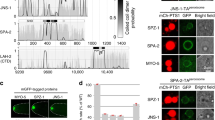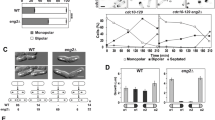Abstract
Polarized exocytosis requires coordination between the actin cytoskeleton and the exocytic machinery responsible for fusion of secretory vesicles at specific sites on the plasma membrane1. Fusion requires formation of a complex between a vesicle-bound R-SNARE and plasma membrane Qa, Qb and Qc SNARE proteins2. Proteins in the lethal giant larvae protein family, including lethal giant larvae and tomosyn in metazoans and Sro7 in yeast, interact with Q-SNAREs and are emerging as key regulators of polarized exocytosis3. The crystal structure of Sro7 reveals two seven-bladed WD40 β-propellers followed by a 60-residue-long ‘tail’, which is bound to the surface of the amino-terminal propeller. Deletion of the Sro7 tail enables binding to the Qbc SNARE region of Sec9 and this interaction inhibits SNARE complex assembly. The N-terminal domain of Sec9 provides a second, high-affinity Sro7 interaction that is unaffected by the tail. The results suggest that Sro7 acts as an allosteric regulator of exocytosis through interactions with factors that control the tail. Sequence alignments indicate that lethal giant larvae and tomosyn have a two-β-propeller fold similar to that of Sro7, but only tomosyn appears to retain the regulatory tail.
This is a preview of subscription content, access via your institution
Access options
Subscribe to this journal
Receive 51 print issues and online access
$199.00 per year
only $3.90 per issue
Buy this article
- Purchase on Springer Link
- Instant access to full article PDF
Prices may be subject to local taxes which are calculated during checkout




Similar content being viewed by others
References
Pruyne, D., Legesse-Miller, A., Gao, L., Dong, Y. & Bretscher, A. Mechanisms of polarized growth and organelle segregation in yeast. Annu. Rev. Cell Dev. Biol. 20, 559–591 (2004)
Jahn, R. & Scheller, R. H. SNARE—engines for membrane fusion. Nature Rev. Mol. Cell Biol. 7, 631–643 (2006)
Wirtz-Peitz, F. & Knoblich, J. A. Lethal giant larvae take on a life of their own. Trends Cell Biol. 16, 234–241 (2006)
Lehman, K., Rossi, G., Adamo, J. E. & Brennwald, P. Yeast homologues of tomosyn and lethal giant larvae function in exocytosis and are associated with the plasma membrane SNARE, Sec9. J. Cell Biol. 146, 125–140 (1999)
Zhang, X. et al. Lethal giant larvae proteins interact with the exocyst complex and are involved in polarized exocytosis. J. Cell Biol. 170, 273–283 (2005)
Grosshans, B. L. et al. The yeast lgl family member Sro7p is an effector of the secretory Rab GTPase Sec4p. J. Cell Biol. 172, 55–66 (2006)
Adamo, J. E., Rossi, G. & Brennwald, P. The Rho GTPase Rho3 has a direct role in exocytosis that is distinct from its role in actin polarity. Mol. Biol. Cell 10, 4121–4133 (1999)
Adamo, J. E. et al. Yeast Cdc42 functions at a late step in exocytosis, specifically during polarized growth of the emerging bud. J. Cell Biol. 155, 581–592 (2001)
Kagami, M., Toh-e, A. & Matsui, Y. Sro7p, a Saccharomyces cerevisiae counterpart of the tumor suppressor l(2)gl protein, is related to myosins in function. Genetics 149, 1717–1727 (1998)
Vasioukhin, V. Lethal giant puzzle of Lgl. Dev. Neurosci. 28, 13–24 (2006)
Gracheva, E. O. et al. Tomosyn inhibits synaptic vesicle priming in Caenorhabditis elegans. PLoS Biol. 4, e261 (2006)
McEwen, J. M., Madison, J. M., Dybbs, M. & Kaplan, J. M. Antagonistic regulation of synaptic vesicle priming by Tomosyn and UNC-13. Neuron 51, 303–315 (2006)
Musch, A. et al. Mammalian homolog of Drosophila tumor suppressor lethal (2) giant larvae interacts with basolateral exocytic machinery in Madin-Darby canine kidney cells. Mol. Biol. Cell 13, 158–168 (2002)
Hatsuzawa, K., Lang, T., Fasshauer, D., Bruns, D. & Jahn, R. The R-SNARE motif of tomosyn forms SNARE core complexes with syntaxin 1 and SNAP-25 and down-regulates exocytosis. J. Biol. Chem. 278, 31159–31166 (2003)
Pobbati, A. V., Razeto, A., Boddener, M., Becker, S. & Fasshauer, D. Structural basis for the inhibitory role of tomosyn in exocytosis. J. Biol. Chem. 279, 47192–47200 (2004)
Mohri, K., Vorobiev, S., Fedorov, A. A., Almo, S. C. & Ono, S. Identification of functional residues on Caenorhabditis elegans actin-interacting protein 1 (UNC-78) for disassembly of actin depolymerizing factor/cofilin-bound actin filaments. J. Biol. Chem. 279, 31697–31707 (2004)
Voegtli, W. C., Madrona, A. Y. & Wilson, D. K. The structure of Aip1p, a WD repeat protein that regulates cofilin-mediated actin depolymerization. J. Biol. Chem. 278, 34373–34379 (2003)
Betschinger, J., Eisenhaber, F. & Knoblich, J. A. Phosphorylation-induced autoinhibition regulates the cytoskeletal protein Lethal (2) giant larvae. Curr. Biol. 15, 276–282 (2005)
Baba, T., Sakisaka, T., Mochida, S. & Takai, Y. PKA-catalyzed phosphorylation of tomosyn and its implication in Ca2+-dependent exocytosis of neurotransmitter. J. Cell Biol. 170, 1113–1125 (2005)
Brennwald, P. et al. Sec9 is a SNAP-25-like component of a yeast SNARE complex that may be the effector of Sec4 function in exocytosis. Cell 79, 245–258 (1994)
Fasshauer, D., Sutton, R. B., Brunger, A. T. & Jahn, R. Conserved structural features of the synaptic fusion complex: SNARE proteins reclassified as Q- and R-SNAREs. Proc. Natl Acad. Sci. USA 95, 15781–15786 (1998)
Goud, B., Salminen, A., Walworth, N. C. & Novick, P. J. A GTP-binding protein required for secretion rapidly associates with secretory vesicles and the plasma membrane in yeast. Cell 53, 753–768 (1988)
Boyd, C., Hughes, T., Pypaert, M. & Novick, P. Vesicles carry most exocyst subunits to exocytic sites marked by the remaining two subunits, Sec3p and Exo70p. J. Cell Biol. 167, 889–901 (2004)
Gari, E., Piedrafita, L., Aldea, M. & Herrero, E. A set of vectors with a tetracycline-regulatable promoter system for modulated gene expression in Saccharomyces cerevisiae. Yeast 13, 837–848 (1997)
Baker, N. A., Sept, D., Joseph, S., Holst, M. J. & McCammon, J. A. Electrostatics of nanosystems: application to microtubules and the ribosome. Proc. Natl Acad. Sci. USA 98, 10037–10041 (2001)
Landau, M. et al. ConSurf 2005: the projection of evolutionary conservation scores of residues on protein structures. Nucleic Acids Res. 33, W299–W302 (2005)
Nicholson, K. L. et al. Regulation of SNARE complex assembly by an N-terminal domain of the t-SNARE Sso1p. Nature Struct. Biol. 5, 793–802 (1998)
Acknowledgements
We thank L. Katz for help with the yeast two-hybrid analysis, and S. Kaiser for assistance with mass spectrometry. Diffraction data were measured at the Advanced Light Source and the Stanford Synchrotron Radiation Laboratory. D.A.H. was supported by a fellowship from the American Cancer Society. This work was supported by NIH grants to P.J.B. and W.I.W and a grant from the G. Harold and Leila Y. Mathers Foundation to P.J.B.
Author Contributions Crystallographic and biochemical experiments were designed by D.A.H. and W.I.W. and performed by D.A.H. Plasmid and strain construction were designed and performed by D.A.H. and P.J.B. Yeast two-hybrid analysis, secretion assays and analysis of mutant phenotypes were designed by P.J.B. and performed by A.A. and A.G. D.A.H. and W.I.W. wrote the paper and all authors made editorial comments.
Coordinates and structure factors have been deposited in the Protein Data Bank under accession number 2OAJ.
Author information
Authors and Affiliations
Corresponding authors
Ethics declarations
Competing interests
. Reprints and permissions information is available at www.nature.com/reprints. The authors declare no competing financial interests.
Supplementary information
Supplementary Information
The file contains Supplementary Materials and Methods, Supplementary Tables 1-2, and Supplementary Figures S1-S7 with legends. (PDF 4979 kb)
Rights and permissions
About this article
Cite this article
Hattendorf, D., Andreeva, A., Gangar, A. et al. Structure of the yeast polarity protein Sro7 reveals a SNARE regulatory mechanism. Nature 446, 567–571 (2007). https://doi.org/10.1038/nature05635
Received:
Accepted:
Issue Date:
DOI: https://doi.org/10.1038/nature05635
This article is cited by
-
Mechanisms of SNARE proteins in membrane fusion
Nature Reviews Molecular Cell Biology (2024)
-
Genome-wide identification and analysis of WD40 proteins in wheat (Triticum aestivum L.)
BMC Genomics (2018)
-
PAR3–PAR6–atypical PKC polarity complex proteins in neuronal polarization
Cellular and Molecular Life Sciences (2018)
-
RETRACTED ARTICLE: The exocyst in Candida albicans polarized secretion and filamentation
Current Genetics (2016)
-
Structure and function of WD40 domain proteins
Protein & Cell (2011)
Comments
By submitting a comment you agree to abide by our Terms and Community Guidelines. If you find something abusive or that does not comply with our terms or guidelines please flag it as inappropriate.



